Week 2 Task 2: Substitution fractals
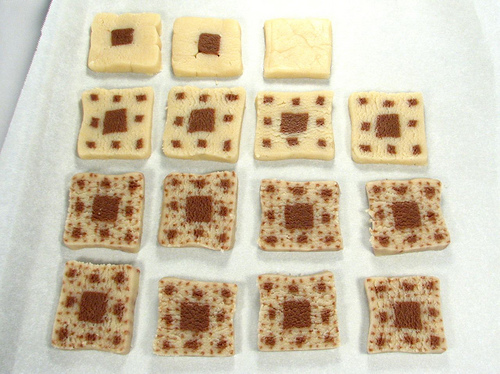
Fractal cookies by Evil Mad Scientist
Today your mission is…
Create your own substitution fractal and use it to explore multiplication.
Ready, Set, Go
Find a picture you like, with prominent parts inside its outline. The object can contain the parts, such as an owl’s head with two big eyes, or an open book with large illustrations. Or it can be made of the parts, for example, a word out of letters, or a window out of panels. You can also start with an abstract shape, like a triangle split into triangles.
Replace each part with a miniature copy of the whole shape. Repeat several times. You just drew several levels of a substitution fractal!
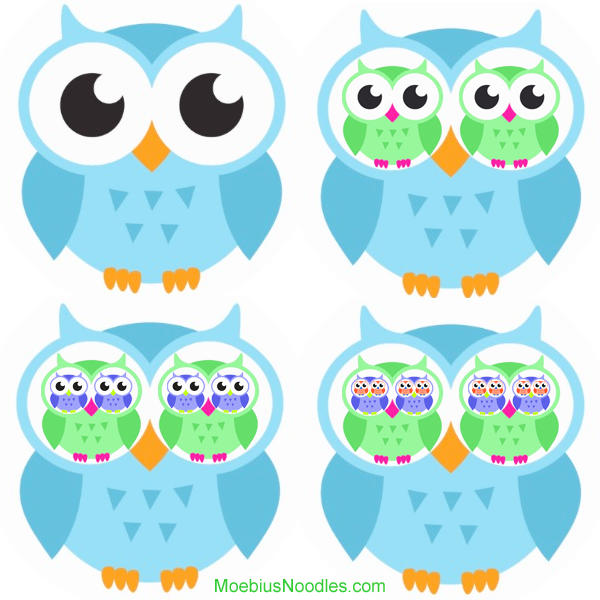
Respond to today's task
- What multiplication ideas do you see in this topic? How about ideas inspired by calculus?
- Did you use this with kids or students? How did it go? What did they say and do? What questions did they ask?
Help your child to get started
Some children can’t resist large-scale projects and making a substitution fractal is perfect for them. Get the largest piece of paper you can find and start big, with the base object taking up the entire sheet. Or take this activity outside where you can draw with chalk.
Draw a fractal based on a shape your child loves - a toy, a setting, an idea. Tell a story of what’s happening and encourage your child to add details to the story as you draw new levels of the fractal.
Toddlers
If your toddler likes stickers and collages, cut shapes out of different-color paper for different levels. Fold paper to cut several shapes at once. Or you can make fractal cookies out of real or play dough.
Young kids
Children realize early on that words are made out of letters. How about letters made out of words? Your kids can use this software to make math birthday cards for friends and relatives. http://www.edboas.com/science/ftext/index.html
Older kids
The study of fractals picked up in the late 1960s, with the use of computers. Tech literacy is essential for studying fractals beyond the first introduction to the idea. Make extreme and outlandish art with Droste Effect software: http://www.photospiralysis.com/
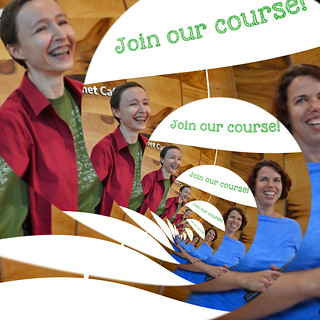
How is this multiplication?
Like tree fractals, substitution fractals support the foundations of our number system, but in a different way. Tree fractals show groups of groups of groups, for example, tens of tens of tens making a thousand. Substitution fractals can show that too, if you zoom out through their levels. But substitution fractals also show parts of parts of parts, such as one-tenth of one-tenth of one-tenth of a meter making a millimeter. This is one of the most systematic (and gorgeous) ways to explore multiples and fractions, positive and negative powers, multiplication and division within a single unifying pattern.
Inspired by calculus
Substitution fractals focus inward: you zoom in, almost like a microscope. They help children imagine not only infinitely large, but infinitely small, infinitesimal objects. It’s interesting to note that in a group, girls often prefer the subtlety and inward focus of substitution fractals, and boys often prefer the big expansion of tree fractals.
Frequently Asked Question
What if I can’t draw at all?!!
Babies don’t care if their parents finished their opera training before singing lullabies! However poorly you draw, kids will appreciate you drawing for them. But if you are anxious, start from simple geometric shapes, such as squares and triangles. You can also borrow someone’s math goggles, so to speak, to see how more complex objects come together from simple shapes. If all else fails, a circle with two triangles always makes a good cat portrait!
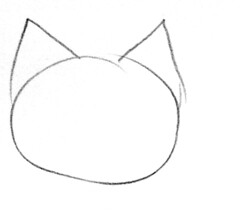
Words
Fractal, scale, power, exponent, recursion, zoom, reverse
Scavenger hunt

Matryoshka, by Radiology Art
Seek substitution fractals and nested pictures in art. They appear in abstract designs, such as nested dolls, but also in philosophical or symbolic art pieces, such as Bruegel’s “Big fish eat small fish.” Nested structures also appear in traditional architecture (check out these fractal villages in Africa), rhymes, and stories, such as “This is the house that Jack built.”

Fractal geometry will make you see everything differently. There is a danger in reading further. You risk the loss of your childhood vision of clouds, forests, flowers, galaxies, leaves, feathers, rocks, mountains, torrents of water, carpet, bricks, and much else besides. Never again will your interpretation of these things be quite the same.
- Michael Barnsley
Course links
- All course tasks
- Multiplication Lounge: our open forum for questions, comments, and ideas
- Course participants survey
People who like this
Your answer

Answer by SarahKrieger · May 01, 2014 at 06:01 AM
I didn't really relate to this activity until I saw everyone else's great work. We ended up using playdough and the star shaped cookie cutters that nest inside each other. We talked about seeing the same image if we were to zoom in or out.
Answer by ChristyM · Apr 28, 2014 at 09:49 PM
To me, this activity suggests a more complex function than straightforward multiplication or division. I definitely see the calculus feature as the function is repeated.
Both of my children really enjoyed this activity. One did a self portrait and repeated until we reached the limit due to pixels.
The other cut pieces of paper smaller and smaller. She then cut a hole in the big sheet and put the smaller piece inside, then put the next smaller piece inside and so on.
By the way, we actually did these activities day by day in order, not as I posted the answers.
I am hoping to post pictures as my children really love seeing their work next to everyone else's, but need to get some time on the actual computer to reformat the pictures.
Answer by champalto · Apr 16, 2014 at 09:37 PM
The great thing about this whole experience is my math-skeptical 8-year-old is getting into it! He is actually quite good at math - just unsure why he should care about it. I am very excited! Both he and his sister are Minecraft fans, so here are their Minecraft-inspired substitution fractals. (I am told one is a ghast and one is a creeper.)


Fractal Creeper - awesome! Minecraft is excellent for exploring mathematics, but also for inspiring kids to try things like this offline.
Answer by pkouch · Apr 18, 2014 at 11:30 PM
My international student from Korea made a lotus in a couple of minutes after I introduced the class to substitution fractals. I didn't have my cell phone with me to take a picture, but I found this similar image online.

@pkouch, the previous response from @sherylmorris about Montessori pink towers has structures that look amazingly similar to this flower, but in different medium. If you fold paper into squares without half-rotations, the overall shape pops up into a paraboloid:
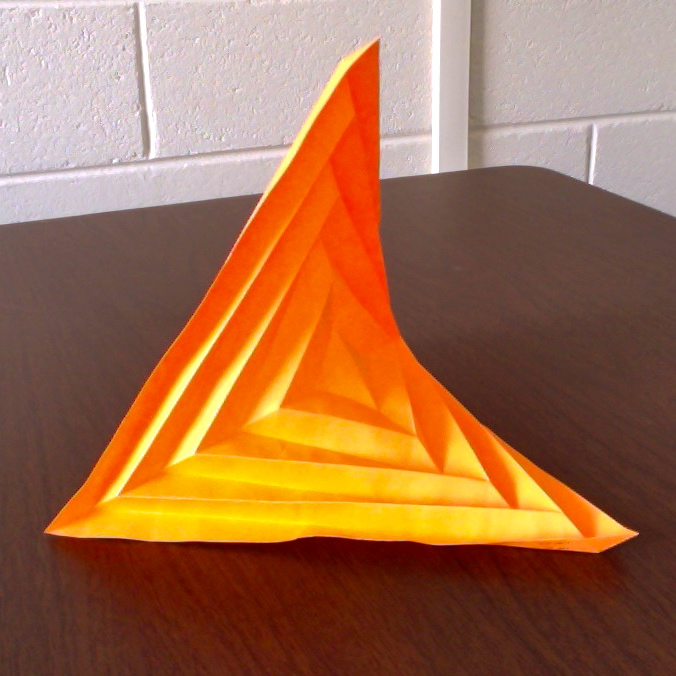
Answer by mistermarty · Apr 22, 2014 at 03:29 PM

I spoke to my son about doing the reverse of yesterday's tree fractals asking him about making something smaller. He did something like this a few weeks ago by folding paper into smaller and smaller dimensions. Today he decided to do some cutting and this is what he came up with. Upon seeing this it dawned on him that the scale model of the U.S.S. Yorktown that he received for Christmas and that we built together uses the same idea as this little project. I'd say it was a good exercise.
@mistermarty, check out the topographic map calculus activity we had a couple of weeks ago at the Math Circle. It's what you did, but with craft foam - so we could play with slopes as well, in 3D.

Answer by mrs123 · Apr 23, 2014 at 02:52 AM
Substitution fractals were a lot easier for my younger children to understand. I'm not sure if it's the concept or if it's because they had already learned about tree fractals and fractals in general the day before. They are really starting to get the idea of infinity through these lessons. Here's my daughter's drawing of a frowning girl:

Nice spatial reasoning there - using the frown as hair. Very clever!
Answer by HappyHEmum · Apr 22, 2014 at 09:48 AM
My 2 loved this activity, we are a little behind schedule but catching up! Very fun way to introduce substitution fractals
Glad this was meaningful for the kids! The course is flexible enough for the schedule, so you are fine.
Answer by AGray · Apr 21, 2014 at 01:56 PM
I love the connection to stories, like "The House that Jack Built". I am going to see if my kids notice that connection! I am going to introduce substitution fractals today. Last week was busy with the Easter holiday, but we did spend some time drawing cat face tree fractals with sidewalk chalk.
Answer by Valerie · Apr 19, 2014 at 08:43 AM
This generated much more interest than tree fractals. After a quick demonstration of hand drawing a series of leaves inside leaves she immediately understood the concept, and produced a face with substitution fractal eyes and nose. Then while we were watching a universe zoom out video as part of the next exercise she drew this as a circular substitution fractal, describing it as a cyclone (something she's very interested in). She was also mesmerized by a musical representation of substitution fractals with zooming - the White Stripes' Seven Nation Army video
Answer by sherylmorris · Apr 15, 2014 at 09:34 PM
 Finding new ways to look and think about Maria Montessori's Pink Tower! Thank you!
Finding new ways to look and think about Maria Montessori's Pink Tower! Thank you!
1x1x1=1 2x2x2=8 3x3x3=27 4x4x4=64 5x5x5=125
6x6x6=216 7x7x7=343 8x8x8=512 9x9x9=729 10x10x10=1,000


I love this flowers use of paper, color and shape. Excellent construction with the simplicity of the model. This is a neat way to emphasize the concept. Explaining how the square must decrees the same amount to create the design. Super!
Answer by Sblair · Apr 18, 2014 at 08:29 PM
My son (9) and I stared at the ceiling of our church. The beams fanned out like a snowflake. We discussed fractals again but this time we use the wooden boards that filled the rest of the area within the snowflake beams. I explained the fractal being on the outside (snowflake) and the substitution (wooden beams) being the infinite number this time, giving the 3 dimensional shape. I explained the importance of area, perimeter and volume to make such a structure look this way from our pew. We will explore more of M.C. Esher art to reinforce fractal concept.
Answer by James · Apr 15, 2014 at 08:07 PM
My daughter was in a fussy mood this morning, so we went with a music fractal, as music often makes her happier. We chose one of the songs from her music class, Frère Jacques. It's 16 measures long, so we pulled out the middle 8, sped up the tune to double time, and inserted that in instead. The double time tune also has a middle (4 bars now), so we put in the original sped up 4 times. Finally, we put in two bars of 8x in the middle of that. We did try even faster, but it was too hard for me to spit out words that fast. Since Frère Jacques is a round, all the iterations can be played at the same time without getting too much clashing of harmonies. Here's the sheet music for "Fractal Jacques", followed by a video me singing the fourth iteration to my daughter along with a midi rendering.

Wow, just wow. Fractal art of all sorts - visual, stories, now music!
Is it okay to share your video? You have it unlisted.
Sure, share away - I just didn't want to pollute YouTube with my singing! If anyone would like to try singing along with their kids, here's the sound file: http://wardlawbailey.com/FractalJacques.mp3.
Thank you for posting this. We did the fractal activities last week, and my kids (4th grade group of 4 girls) had asked to integrate music. I told them that someone had made a fractal of the song Frere Jacque, and asked them how they think you did it. Then it turned into a discovery experience for them, in which they figured out what you did, then we watched your video, then played the music on the piano.
Answer by TraceySeier · Apr 17, 2014 at 04:32 PM
We did substitution fractals on the driveway. The 4.5 yr old and the 2.5 yr old mostly wandered around doing their own chalk drawings, but occasionally came over to comment or suggest color changes. The 2.5 yr old then drew all over one of them to "help". I was wondering if they were getting it, then my 4.5 yr old came over to the cherries and wanted to count how many at each level. Their comments "pretty good".
Answer by Eogruen · Apr 17, 2014 at 02:07 AM

this morning we had a great time drawing chalk fractals in the driveway. My four year old drew the nested tree pattern above the large tree fractal. She was very proud of herself.

My seven year old did a five times five flower design.

I did a four petaled flower substitution fractal, shown here with some cute interference who was more interested in attempting to eat wood chips than learn math.
We wrote on big letters-- tree and pattern fractals, try some at home! Just in case someone walking by wanted to be inspired.
Answer by mirandamiranda · Apr 17, 2014 at 05:42 AM
We started off with me showing the girls (ages 6, 6, 8) the owl fractal which they had seen before and talking about substitution fractals and how they worked. I suggested some other things we could try - houses repeating in their windows, people repeating in their limbs...
Daughter P drew her own version of the owl.
Daughter M tried various smiley faces, a single nesting and a triple one:


We talked about how much harder it was with more points of substitution!
Daughter G at first was anxious and felt she could not contribute. So I got out a book I had been meaning to show them, The Mouse and His Child by Russell Hoban. A key element of the story is the 'Last Visible Dog', an image on a dog food can that features a dog holding a smaller version of the can, which has a smaller dog on it, also with a yet smaller can... Another character describes looking at this image as contemplating infinity: "an endlessness of little dogs, receding though progressive diminution to a revelation of the ultimate truth ... Beyond the last visible dog".
This was more inspiring to us all and we attempting a co-authored rendering (although not strictly adhering to the book's description):

Not super clear, sorry... getting out the story book definitely eased the tension G had been feeling, even though she continued to fret about her dog-drawing abilities.
Then we had a go at the Sierpinski triangle which was a big hit with my most methodical child, P. She asked me to draw the triangles in (I had printed out the worksheet) and she coloured them. She talked about going even further than this but she also insisted on counting all the triangles each time and was exhausted by the time we got to 243!

This was for me the most enlightening in terms of the multiplication involved. I really started to see how with each iteration we were trebling the triangles by drawing 3 triangles in each, and we talked about this as well as how we could multiply instead of counting them all.
We also looked at the word fractals which were fun. Later at dinner G spontaneously suggested making letter fractals, tree ones from each point of A, say, and substitution ones with letters like O. And then she noticed a flower fractal in a film we were watching. So it is definitely sinking in!
One thing I am thinking is that my children don't ask loads of questions. I don't know how much this is habit, or a sign of their interest level. I am going to try and make more of an effort to elicit them in future tasks. I also find that the arithmetical side of the fractals is not something that really interests them, similarly to what another poster mentioned.
I am also finding these activities really great for giving me an insight into how my children learn, what interests and engages them and what does not. I feel like I have learnt more about them from this than from all the workbooks and manipulatives and maths story books and so on we have used so far!
Arithmetic just isn't all that interesting to most people, as branches of mathematics go.
There are several games for brainstorming questions in small groups. You can try them together with math. But some kids generate one or two bigger questions per activity, rather than rapid-shooting tons of little questions all time... And some kids interact non-verbally, in gestures and constructions and building ideas!
Answer by perbui · Apr 17, 2014 at 09:42 AM
I showed my 7yo daughter examples of substitution fractals, and she really thought the ones that had anything to do with animals really cute. When it came time for her to draw, she went for abstract shapes. Instead of multiplying the original design by 2 or more for each subsequent level, she only copied it once, which isn't really multiplication, is it? It is the Droste effect, but I don't really think it's multiplication. We did relate to the examples we found in other places to exponential growth, just like tree fractals, so that was good.
On another note, as a literature tie-in, we read A Grain of Rice by Helena Clare Pittman as an illustration of exponential growth. It was a great way to give the kids a physical representation of these abstract concepts.

Answer by dnamkrane · Apr 16, 2014 at 11:32 PM
Not a skilled visual artist, so I went into my Paint program and started with a base shape of an oval with a diamond circumscribed within it. I copied and reduced that shape so that it would fit into the base shape and repeated that two more times. I was surprised that what looked something like an eye when I started out ending up looking more like a rose petal, as someone below found as well.
Out of curiosity, I reversed the shapes and created a new fractal. What started out looking more like a ring now looks something like the Superman logo :-)
More seriously, I was able to more levels of fractals into the first than the second. The diamond inscribed more easily into the oval than vice versa. There's something there about width versus height that I can't quite put my finger on.


Answer by Caroline_Prochazka · Apr 16, 2014 at 06:26 PM
We only had a little time for this, this week, and so I took the opportunity of a car ride between errands for a discussion about substitution fractals. My 9yo had seem the picture of the owls already at that point and so he caught on quite quickly. We discovered that this was a fractal exercise that would lend itself to Star Wars images - with an example being Darth Vader's helmet copied into the eyes of the helmet much like the owl eyes. My 5yo pointed out that the shape of the mouth grille on Darth Vader's mask is more like the shape of the helmet itself and that he thought this was a better place to zoom in. We talked about how using the eyes is similar to the binary tree fractal where the number doubles each time. Then we wondered if the 'tree fractal' mode of Vader's helmet copied on the mouth grille would be a single line connected to a single line, connected to a single line and so on. Hmmm.
I watched the TED talk on African Village fractals with my 9yo yesterday and he was truly interested. Visual media is always a big sell with him. I think if I had more time, I would seek out larger aerial photos of such villages and have him trace the fractal geometry with different colour markers.
The Breugel painting interested both kids, but we had difficulty finding more such work - does Breugel have more in this vein? Springing from this, I started doodling with my 9yo a string of pearls, where each 'pearl' then became a finer string of pearls, and so on. A string with 13 pearls was simple, 13 smaller 'pearls' in each of those 13 would be 169, already a big enough number. The next iteration got us to 2197 which hit home - "whoa! now that's a LOT of beans".
Only after I we were moving on with our day, did the 5yo show some interest in these doodles. He was equally impressed, I think. Just coming at it as a new discovery - "look! this loop is made up of smaller loops, and there are more loops in that".
So they seem to understand the geometry of the topic, and the elder understands how this is tied to multiplication, but is not really interested in expressing much of it in numerals on paper. I see another participant has noted that the thrill in this is that it makes math 'fun', and we have been craving more of just this type of thing.
Spatial understanding of multiplication is valuable in its own right, even without numerical connections.
I think fish-within-fish was a one-off idea for Bruegel, but check out the Droste Effect group on Flickr. Here's my Old Empire contribution:

Answer by CynthiaDadmun · Apr 16, 2014 at 05:41 PM
This morning my 3yo and 5yo worked on the Sierpinski fractal (http://fractalfoundation.org/resources/fractivities/sierpinski-triangle/) (Thanks for that link, babyhclimber!) That was just about their speed. Here are their triangles. I had to help my 3yo with some of the lines, and she also had a little trouble cutting! 5yo got it.

We also talked about how the drawn triangles can't really go on forever, since the marker is too thick, and even the printed one is limited by the size of the little globs of ink. But a zoom-in movie on the computer CAN go on forever (http://math.bu.edu/DYSYS/animations/sierp-zoom.html) because the computer is using the mathematical rules to figure it out over and over. Hoping that plants the seed of the idea that the mathematical IDEA is bigger than the representation of it on paper (ie, the printout is just a model of the real Sierpinski triangle, which is a concept). And... I think the ST printout lends itself to a fun little puzzle.

Follow this Question
Related Questions
Week 2 Task 4: Sequences and series 23 Answers
Week 2 Task 5: Multiplication towers 20 Answers
Week 2 Task 1: Tree fractals 49 Answers
Week 2 Task 3: Zoom and powers 22 Answers


